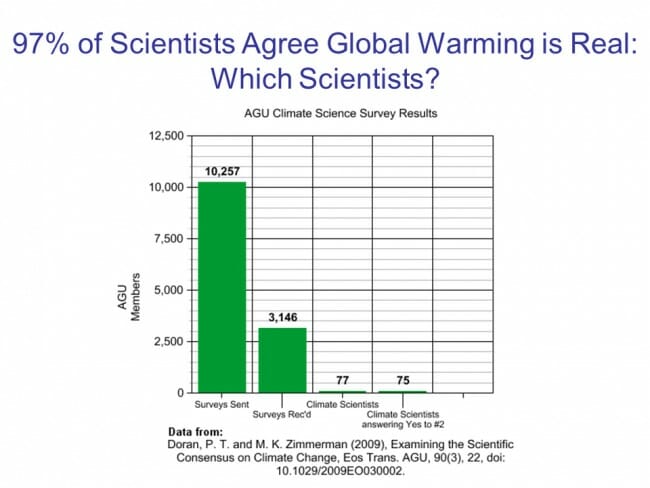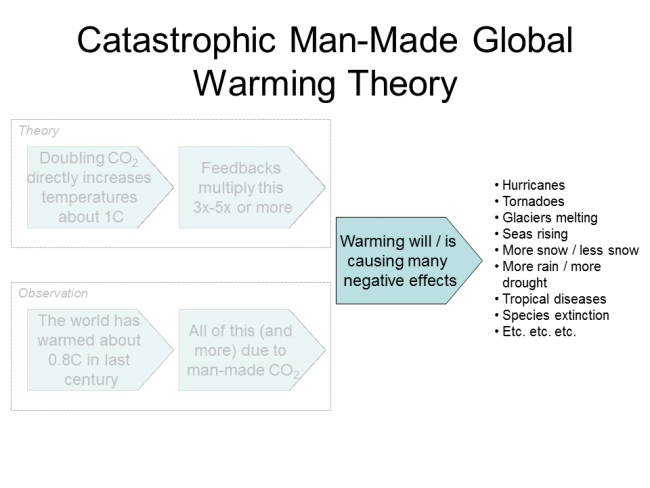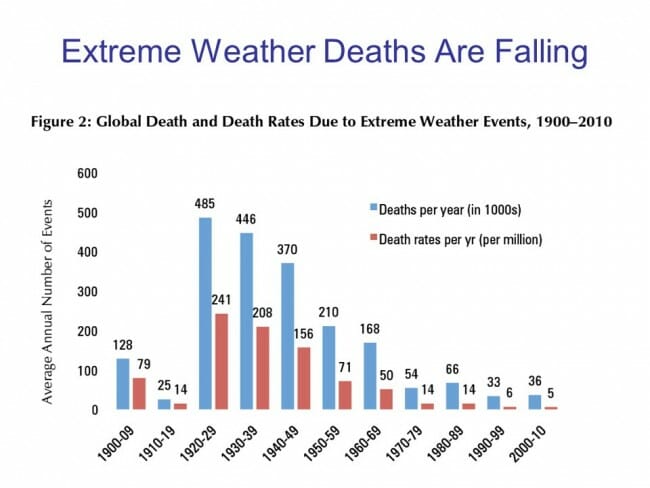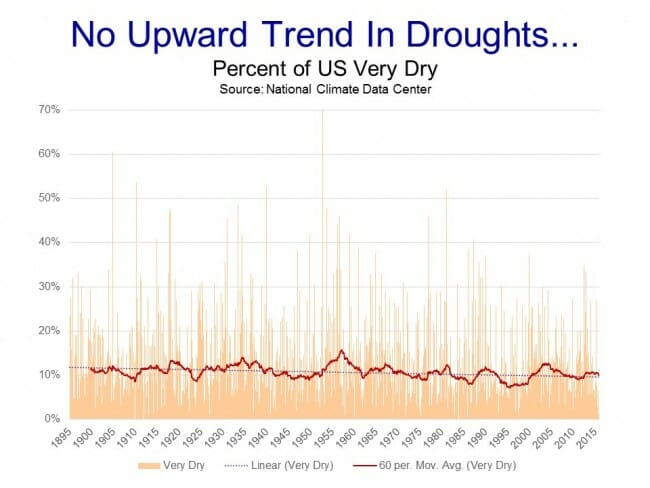Denying the Climate Catastrophe: 8. The Lukewarmer Middle Ground
This is Chapter 8 of an ongoing series. Other parts of the series are here:
- Introduction
- Greenhouse Gas Theory
- Feedbacks
- A) Actual Temperature Data; B) Problems with the Surface Temperature Record
- Attribution of Past Warming: A) Arguments for it being Man-Made; B) Natural Attribution
- Climate Models vs. Actual Temperatures
- Are We Already Seeing Climate Change
- The Lukewarmer Middle Ground (this article)
- A Low-Cost Insurance Policy
In this chapter we are going to try to sum up where we are and return to our very first chapter, when I said that we would find something odd once we returned to the supposed global warming "consensus".
First, let's return to our framework one last time and try to summarize what has been said:
I believe that this is a pretty fair representation of the median luke-warmer position. Summarized, it would be:
- Manmade CO2 warms the Earth, though by much less than most climate models claim because these models are assuming unrealistic levels of positive feedback that over-state future warming. One degree C of warming, rather than four or five, is a more realistic projection of man-made warming over the next century
- The world has certainly warmed over the last century, though by perhaps a bit less than the 0.8C in the surface temperature record due to uncorrected flaws in that record
- Perhaps half of this past warming is due to man, the rest due to natural variability
- There is little evidence that weather patterns are "already changing" in any measurable way from man-made warming
The statements I just wrote above, no matter how reasonable, are enough to get me and many others vilified as "deniers". You might think that I am exaggerating -- that the denier tag is saved for folks who absolutely deny any warming effect of CO2. But that is not the case, I can assure you from long personal experience.
The Climate Bait and Switch
Of course, the very act of attempting to shut people up who disagree with one's position on a scientific issue is, I would have thought, obviously anti-science. The history of science is strewn with examples of the majority being totally wrong. Even into the 1960's, for example, the 97% consensus in geology was that the continents don't move and that the few scientists who advocated for plate tectonics theory were crackpots.
But that is not how things work today. Climate action advocates routinely look for ways to silence climate skeptics, up to and including seeking to prosecute these climate heretics and try to throw them in jail.
The reason that alarmists say they feel confident in vilifying and attempting to silence folks like myself is because they claim that the science is settled, that 97% of climate scientists believe in the consensus, and so everyone who is not on board with the consensus needs to shut up. But what exactly is this consensus?
The 97% number first appeared in a "study" by several academics who sent out a survey to scientists with some climate change questions. They recieved over 3146 responses, but they decided that only 77 of these respondents "counted" as climate scientists, and of these 75 of the 77 (97%) answered two questions about climate change in the affirmative.
We will get to the two questions in a second, but note already the odd study methodology. If the other 10,000 plus people sent the survey were not the targets of the survey, why were they sent a survey in the first place? It makes one suspicious that the study methodology was changed mid-stream to get the answer they wanted.
Anyway, what is even more fascinating is the two questions asked in the survey. Here they are:
- When compared with pre-1800s levels, do you think that mean global temperatures have generally risen, fallen, or remained relatively constant?
- Do you think human activity is a significant contributing factor in changing mean global temperatures?
The 97% in this survey answered the questions "risen" and "yes".
Do you see the irony here? If you have been following along with this series, you should be able to say how I would have answered the two questions. I would certainly have said "risen" to 1. The answer to question 2 is a bit hard because "significant" is not defined, but in a complex system with literally thousands of variables, I would have said one of those variables was a significant contributor at anything over about 10%. Since I estimated man's effect on past warming around 40-50%, I would have answered "yes" to #2! In fact, most every prominent science-based skeptic I can think of would likely have answered the same.
So you heard it right -- I and many prominent skeptics are part of the 97% consensus. Effectively, I am being told to shut up and not continue to say what I think, in the name of a 97% consensus that represents exactly what I am saying. This is so weird as to be almost Kafka-esque.
This is what I call the climate bait and switch. Shaky assumptions about things like high positive feedback assumptions are defended with the near-certainty that surrounds unrelated proposition such as the operation of the greenhouse gas effect.
In fact, merely arguing about whether man-made warming exists or is "significant" falls well short of what we really need in the public policy arena. What we really should be discussing is a proposition like this:
Is manmade CO2 causing catastrophic increases in warming and warming-driven weather effects whose costs exceed those of reducing CO2 production enough to avoid these effects?
It is about at this point when I usually have people bring up the precautionary principle. So that I am not unfair to proponents of that principle, I will use the Wikipedia definition:
if an action or policy has a suspected risk of causing harm to the public, or to the environment, in the absence of scientific consensus (that the action or policy is not harmful), the burden of proof that it is not harmful falls on those taking an action that may or may not be a risk.
The principle is used by policy makers to justify discretionary decisions in situations where there is the possibility of harm from making a certain decision (e.g. taking a particular course of action) when extensive scientific knowledge on the matter is lacking. The principle implies that there is a social responsibility to protect the public from exposure to harm, when scientific investigation has found a plausible risk. These protections can be relaxed only if further scientific findings emerge that provide sound evidence that no harm will result.
I believe that, as stated, this is utter madness. I will give you an example. Consider a vaccine that saves thousands of lives a year. Let's say, as is typical of almost every vaccine, that it also hurts a few people, such that it may kill 1 person for every thousand it saves. By the precautionary principle as stated, we would never have approved any vaccine, because the precautionary principle does not put any weight on avoided costs of the action.
So take fossil fuel burning. Proponents of taking drastic action to curb fossil fuel use in the name of global warming prevention will argue that until there is an absolute consensus that burning fossil fuels is not harmful to the climate, such burning should be banned. But it ignores the substantial, staggering, unbelievably-positive effects we have gained from fossil fuels and the technology and economy they support.
Just remember back to that corn yield chart.
Bill McKibbon wants us to stop using fossil fuels because they may cause warmer temperatures that might reduce corn yields. But there is a near absolute certainty that dismantling the fossil fuel economy will take us back to the horrendous yields in the yellow years on this chart. Proponents of climate action point to the possibility of warming-based problems, but miss the near certainty of problems from elimination of fossil fuels.
Over the last 30 years, something unprecedented in the history of human civilization has occurred -- an astounding number of people have exited absolute poverty.
Folks like McKibbon act like there is no downside to drastically cutting back on fossil fuel use and switching to substantially more expensive and less convenient fuels, as if protecting Exxon's profits are the only reason anyone would possibly oppose such a measure. But the billion or so people who have exited poverty of late have done so by burning every bit of fossil fuels than can obtain, and never would have been able to do so in such numbers had such an inexpensive fuel option not been available. We in the West could likely afford having to pay $50 a month more for fuel, but what of the poor of the world?
Perhaps this will give one an idea of how central inexpensive fossil fuels are to well-being. This is a chart from World Bank data plotting each country based on their per capital CO2 production and their lifespan.
As you can see, there is a real, meaningful relationship between CO2 production and life expectancy. In fact, each 10x increase in CO2 production is correlated with 10 years of additional life expectancy. Of course, this relationship is not direct -- CO2 itself does not have health benefits (if one is not a plant). But burning more CO2 is a byproduct of a growing technological economy, which leads to greater wealth and life expectancy.
The problem, then, is not that we shouldn't consider the future potential costs and risks of climate change, but that we shouldn't consider them in a vaccuum without also considering the costs of placing severe artificial limits on inexpensive fossil fuels.
People often say to me that climate action is an insurance policy -- and they ask me, "you buy insurance, don't you?" My answer invariably is, "yes, I buy insurance, but not when the cost of the policy is greater than the risk being insured against."
As it turns out, there is an approach we can take in this country to creating a low-cost insurance policy against the risks that temperature sensitivity to CO2 is higher than I have estimated in this series. I will outline that plan in my final chapter.
Here is Chapter 9: A Low-Cost Insurance Policy

































